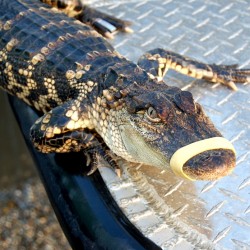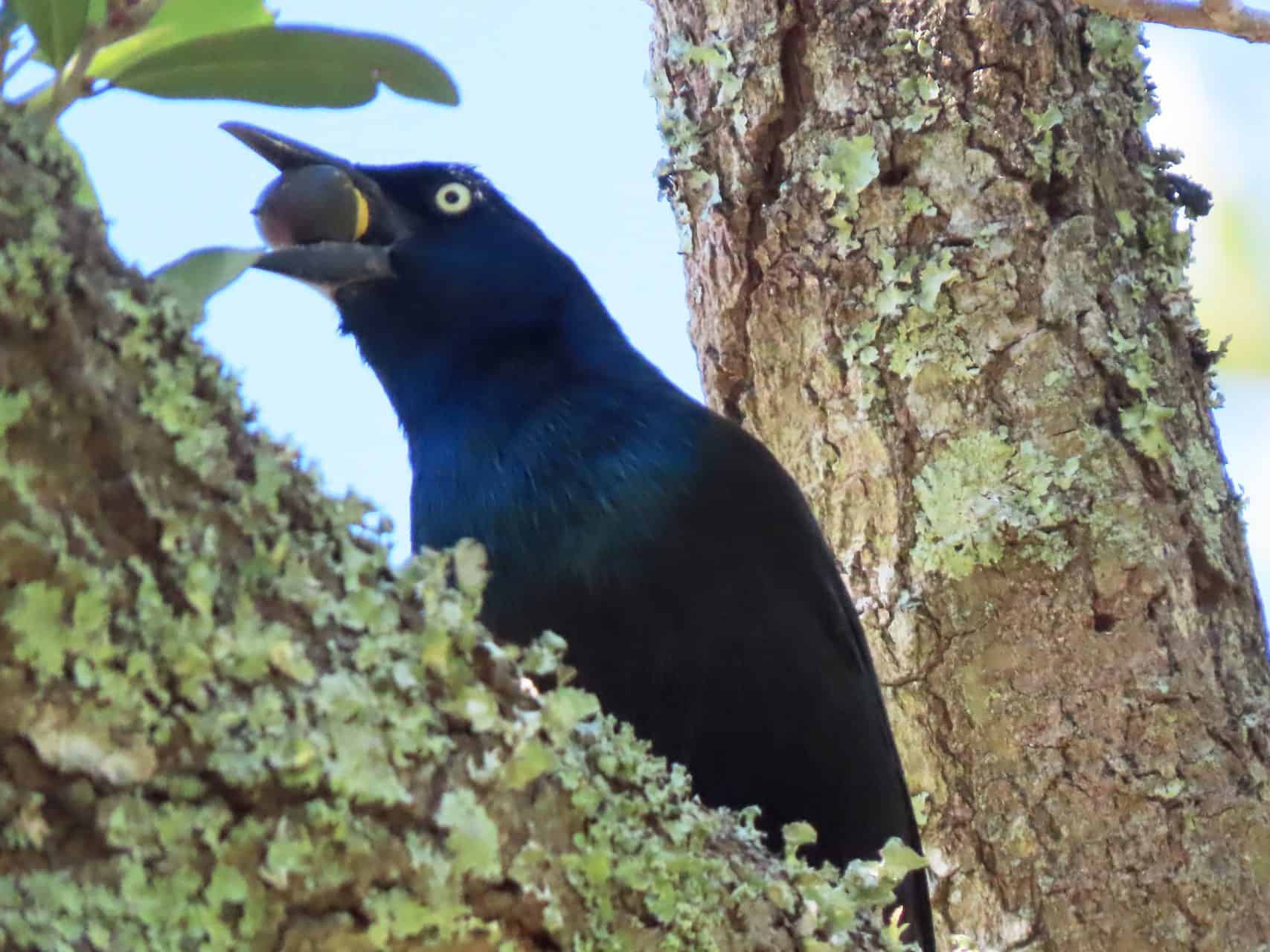Farm Alligator Returns
Farm Alligator Returns. Sounds like the title of a children’s picture book, doesn’t it? Far from kids’ play, the return of alligators is big business in coastal Louisiana. Several times a year in the low-lying areas of brackish, intermediate, and freshwater marshes, a curious practice takes place. One must pay close to attention in order to witness the event, because not much fanfare precedes it.
So it was that I stumbled upon this interesting occurrence early one hot and humid June morning. An odd combination of outboard boats, airboats, and livestock trailers crowded the boat launch, where men scurried back and forth from the trailers to the various boats, hauling burlap sacks filled with fragile cargo.
Camera in hand, I approached the men, asking what they were up to on this fine morning. They chuckled as though I’d said something comical. Too busy to be bothered by the likes of me, they continued their work. Since they didn’t run me off, I continued poking around, looking in the trailer, snapping photos, until one kind soul finally took pity on me, saying, “Hey! We’re returning gators to the marsh! Wanna see?”
Does an alligator have teeth? Sure I wanted to see, and I wanted to ask a thousand questions, too. The nice young man then pulled a three-foot gator out of a burlap sack and explained to me that the young gators came from an alligator farm, where they had hatched a couple of years before. He explained to me that a percentage of all wild eggs hatched on alligator farms in Louisiana must be returned to the marsh from whence the eggs were collected.
Harvesting of alligator eggs is big business in coastal Louisiana. This 12% annual hatchling return is part of the State Alligator Program and has proven very beneficial to sustaining the state’s wild alligator populations. While doing these returns is a costly process for the gator farmer, it is an integral necessity of the program, considering the large number of eggs collected each summer. Additionally, returning the young reptiles after they reach two to three feet in length significantly increases their chances of survival, as opposed to hatching in the wild.
Now that we know why the young gators are returned, let’s talk about how they are returned.
Before leaving the farm, the youngsters are measured, sexed, tagged, tail-notched and recorded. Tail notching is the actual cutting of a pattern in the tail to indicate that it came from a farm. This knowledge provides the state program with valuable information about the gator–its age, when it was released, its growth rate, and how long it survived in the wild after release–if captured in the future.
In preparation for the transport, the ranch hands place big rubber bands around the gators’ snouts to prevent any accidental bites. They next place the gators in burlap sacks, tie the ends with a cord, and then tie them to the railing inside livestock trailers. Once the trailers reach their destination, a fleet of outboard boats and airboats meets them at the landing, where the workers then transfer the sacks onto the various boats. The boats then travel to the areas of marsh from whence the eggs came, where the sacks are opened, the bands removed, and the gators set free.
If you’re concerned that these toddler reptiles, having been farm fed up to this point, can’t fend for themselves, worry no more. These creatures instinctively know how to hunt for their meals in the wild. Keep in mind, too, that being released at this age and size increases their chances of survival in the wild. Meanwhile, the Louisiana Department of Wildlife and Fisheries (LDWF) continues to monitor the positive impacts of this return program.
If you’re wondering just how prolific American alligator populations are, wonder no more. During the 2012 alligator egg harvest, gator farmers collected 413,648 eggs, resulting in 349,514 hatchling alligators, of which 24,489 made it back into the wild. During the 2012 month-long alligator hunting season, hunters harvested 34,376 alligators with an average length of 7.5 feet. The same year, farmers harvested 280,000 farm-raised alligators, with an average length of 4.25 feet. In 2013, farmers released another 32,166 farm raised alligators into the wild. As of January 2013, there were 55 licensed farmers in Louisiana with on-farm inventories totaling 565,036 alligators. That’s a lot of alligator purses, my friends.
The State Alligator Program is a prime example of bringing back life to an endangered species and sustaining those thriving populations. However, this article just barely scratches the surface of this complex and multi-faceted program. For now, rest assured that the LDWF has everything under control and that the American alligator is alive and well in Louisiana. Furthermore, with the decrease in demand for animal-hide products, there is a big chance that we might soon be requiring the services of the “Nuisance Alligator Program”. But that story will have to wait for another day.
Gator tails to you!
BW












What a fantastic adventure – would have loved to have been there to see it, but yer article & photos do it a great justice! Ye know how much we love & respect the Gators!
It’s all so fascinating, isn’t it? Two weeks ago, the swamp was buzzing with the sounds of helicopters while the men marked the nests full of eggs. Then last week, the swamp was buzzing with the motors of airboats actually collecting the eggs from the nests. The return of young gators preceded both of these events. May and June are busy times for those involved in gator conservation! The only thing they won’t let me do is ride with them out to collect eggs. One day . . . .
Reading this while “Swamp People” is on my TV in the background. A natural.
Gator trailer smelled great I imagine. I didn’t know the released gators’ tails were notched like that. The number of eggs gathered, hatched, cared for, then fed for a few years and released, are staggering. I knew it was a lot but didn’t realize the quantity compared to the number of adults harvested during gator hunting. No wonder the swamp is teeming with them. And not counting the ones that are live “speed bumps” that survive!
As always, your writing is fun and informative. Thanks for sharing your knowledge and experiences with us, Cuz.
Oh my gosh, Cuz! I hadn’t thought about that “speed bump” gator in a while. Sure glad he lived, but so sorry about the damage to Susan’s car, LOL!!!
You stumble along the most interesting people BW! I didn’t realize alligator farming helped the population so much. Another very interesting post!
I think it’s all so interesting to learn about. I’ve been watching these guys do this year after year, and one day I will beg to follow them in my boat to see the actual return of the gators and to photograph it. The other thing, as I said above, is to go with them to collect the eggs … too much liability for them, or that’s what the boss told me.
I had no idea this was going on! It really is a complex system they’re devised, and clearly it’s working just fine. I still remember the day I found these baby gators. It’s pretty obvious that they have a better chance of survival spending some time on the farm. On the other hand, how you gonna keep ’em down on the farm, once they hear the tales of the swamp?
If you keep hanging around, I’ll bet you’ll get some of your photos. I’m sure liability is an issue, and concern that “just sightseers” might make things difficult. But you’re far from just a sightseer, and they’ll figure that out soon enough.
The part I can’t photograph is mainly because they are collecting eggs in private marshes, and short of being on an airboat with them, it’s nearly impossible for me to get out there and photograph the egg collection! Maybe one day . . . .
On the other hand, how you gonna keep ’em down on the farm, once they hear the tales of the swamp?
LOL, best line in this thread!
Isn’t it, though? 🙂
Fascinating process! My daughter & I visited an alligator ranch a few years ago and found it absolutely fascinating. It’s good to be reminded of just how successful this program is. I think I’m overdue for another visit. Would also love to watch the release actually taking place. How exciting. Thanks for sharing it with us.
Welcome to this bayou blog, Betty! There are just so many interesting facets to life on the bayou and wildlife on the bayou! Have you ever taken a swamp tour down this way?
I wouldn’t mind seeing the process in person from start to finish. Not sure what is more dangerous…taking the eggs or returning a gator to the wild.
I think taking the eggs is more dangerous, because that is when the female is actually the fiercest. She guards the nest, so one guy has to watch for her with a big stick to fend her off while the other guy loads up the eggs. And remember that’s not a speedy process since they have to be marked first, and then layered between layers of the nesting material so they don’t crack enroute back to the dock. One day I will get to photograph the egg collecting, one day . . . . .
You should run those fellas down now and make plans for next year.
In the last few years, I have noticed that the Alligators in the canal behind my Dad’s place are no longer very shy of humans. If we are picking blackberries along the edge of they canal, instead of shying away as they used to do, they appear to be curious and approach closer than they have done in years gone by. I fear that the hatch and release programs will lead to gators becoming more brave–which will in turn lead to more gators being killed by homeowners. It guess it’s difficult to find the balance to preserve these creatures.
PJ – Let’s think on this a minute. In my experience on the water with my tours, I think those gators have been fed by humans. Whether someone goes back there and throws old food in the canal or intentionally throws the gators a chicken leg or marshmallow, they are being conditioned not to fear humans. It is not natural for them to approach, even if they were farm raised. They are only at the farm for a couple of years and are not even then hand fed, which you know. So, then, when they are returned to the wild, they must fight for their food among all the other bigger gators. Again, they are very easily conditioned using food, so I hold fast that someone has fed them in that canal. Is that likely? It was great meeting you, by the way!!!!
By the way is this Paulette?
Yes, it’s Paulette 🙂 No one on my Dad’s property has ever fed them, but the canal runs quite some distance so I guess someone else could be feeding them. All of the land that borders the canal is farmland with cattle, so it seem odd that anyone would be going back there to feed the gators. Who knows!
sensational job,the wild photography are so dangerous.
work with alligator is very risky..good job